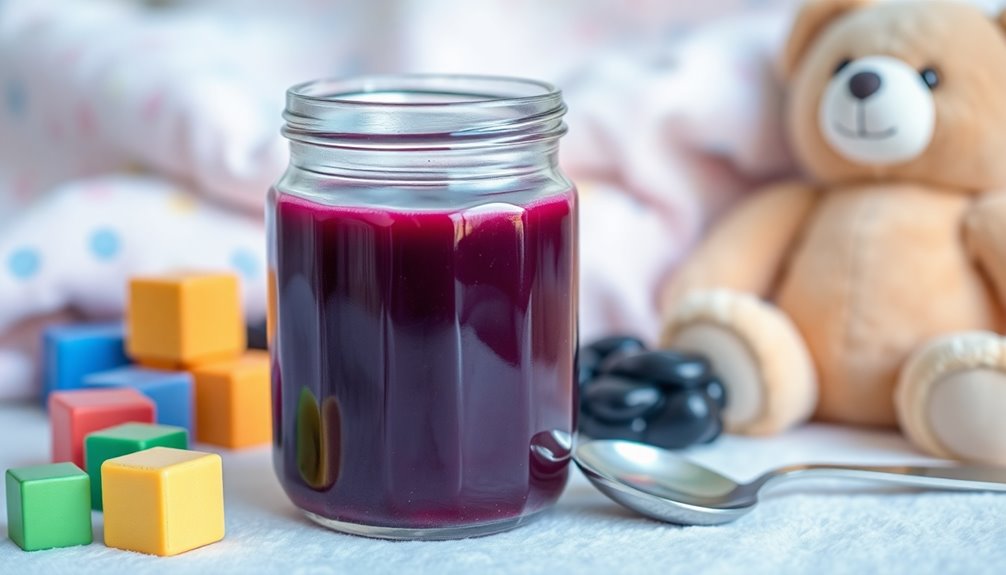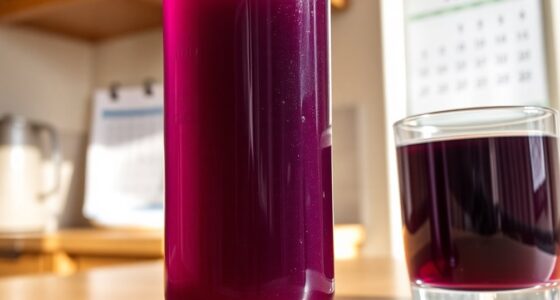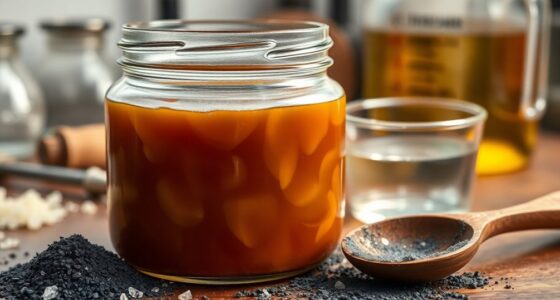For your 6-month-old, start with 1 ounce of diluted prune juice—mix 1 ounce of juice with 1 ounce of water. This helps their digestive system adjust. You can give a maximum of 4 ounces per day, but it's important to consult your pediatrician first. Always monitor your baby's reactions and bowel movements. If you notice any discomfort, consider adjusting the amount. There's much more to learn about introducing new foods safely!
Key Takeaways
- Start with 1 ounce of diluted prune juice (1 ounce juice, 1 ounce water) for a 6-month-old infant.
- Maximum recommended amount for infants under 1 year is 4 ounces per day.
- Always consult a pediatrician before introducing prune juice to your infant's diet.
- Monitor your baby's reactions closely for any signs of discomfort or allergic reactions.
- Ensure adequate hydration by balancing prune juice intake with breast milk or formula.

When introducing prune juice to your 6-month-old, start small to ensure their digestive system adjusts. At this age, your little one might've just begun exploring solid foods, which usually starts around 4 to 6 months. Prune juice can be a helpful addition, especially for infants experiencing constipation. However, it's crucial to approach this new juice with care and consideration.
Begin with an amount that’s safe and manageable. Mixing 1 ounce of prune juice with an equal amount of water is a great way to start. This dilution not only introduces the juice gently but also aids in hydration. For infants under 1 year, the maximum recommended amount of prune juice is 4 ounces per day, but you should only give this under the advice of a pediatrician. As infants adjust to the taste and effects of prune juice, you can gradually increase the quantity if needed, while always paying attention to their reactions. It’s crucial to monitor their bowel movements to ensure they are responding positively. Remember, the prune juice serving size for infants should always be discussed with a pediatrician to ensure it aligns with their individual health needs.
It's essential to consult with your pediatrician before introducing any new food or juice, particularly if your baby is having ongoing issues with constipation.
As your baby transitions from breast milk or formula to solid foods, their digestive system undergoes changes. Introducing new foods too quickly can lead to tummy troubles, and that's why monitoring their reactions is vital. If your baby seems uncomfortable after having prune juice, it's a signal that you might need to adjust the amount or frequency.
Always keep an eye out for any signs of distress or allergic reactions when trying new foods, including juices.
Hydration is key for infants, especially as they start to eat more solid foods. While breast milk or formula is their primary source of nutrition, adding diluted prune juice can help them stay hydrated while also addressing constipation. If you notice your baby struggling with regular bowel movements, prune juice can be a gentle remedy.
Just remember, the goal is to ease their discomfort without overwhelming their young digestive system.
If constipation persists after introducing prune juice, it's time to reach out to your pediatrician. They can provide tailored guidance on your baby's diet and may suggest other solutions. It's important to follow their recommendations closely, as every infant's needs can vary significantly.
Frequently Asked Questions
How Much Prune Juice Should I Give My 6 Month Old for Constipation?
When dealing with constipation in your 6-month-old, you can start by introducing prune juice in a diluted form.
Mix 1 ounce of prune juice with 1 ounce of water and give it once or twice a day.
Keep an eye on your baby for any adverse reactions, and remember, the maximum is 4 ounces daily.
Always consult your pediatrician before starting any new juice to ensure it's safe and suitable for your baby's needs.
What Can I Give My 6 Month Old for Constipation?
If your 6-month-old's experiencing constipation, you can try offering high-fiber baby foods like pureed peas, prunes, or sweet potatoes.
These are gentle on their tummy and can help promote regular bowel movements. You might also consider introducing small amounts of water to keep them hydrated.
Always consult your pediatrician before trying new foods or juices, especially if constipation persists, to ensure it's safe and appropriate for your little one.
How Quickly Does Prune Juice Work?
Isn't it fascinating how quickly some remedies can work?
When you give prune juice, you can expect it to start working within a few hours to a day.
However, remember that each child's digestive system is unique, so results may vary.
If you notice any discomfort or if constipation continues beyond a couple of days, it's wise to consult your pediatrician for advice.
Always keep an eye on your little one's reactions!
Can You Give a Baby Too Much Prunes?
Yes, you can give a baby too much prunes. Overdoing it can lead to diarrhea and abdominal cramping because of the high sorbitol content.
It's important to introduce prunes gradually and monitor your baby's reaction. If you notice signs of discomfort or changes in their stool, you should reduce the amount.
Always consult your pediatrician before making dietary changes to ensure your baby's digestive health remains a priority.
Conclusion
In conclusion, when introducing prune juice to your 6-month-old, start with just a teaspoon mixed into their pureed foods or formula. You'll be amazed at how even a tiny amount can work wonders for their digestion! Always keep an eye on how they react, and don't overdo it—too much can lead to tummy troubles. Remember, every baby's different, so consult your pediatrician if you're unsure. Happy feeding, and may those little tummies thrive!
Cindy thoroughly researches juicing trends, techniques, and recipes to provide readers with practical advice and inspiration. Her writing style is accessible, engaging, and designed to make complex concepts easy to understand. Cindy’s dedication to promoting the advantages of juicing shines through her work, empowering readers to make positive changes in their lives through the simple act of juicing.











